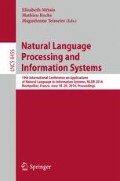Abstract
Tasks such as question answering and semantic search are dependent on the ability of querying & reasoning over large-scale commonsense knowledge bases (KBs). However, dealing with commonsense data demands coping with problems such as the increase in schema complexity, semantic inconsistency, incompleteness and scalability. This paper proposes a selective graph navigation mechanism based on a distributional relational semantic model which can be applied to querying & reasoning over heterogeneous knowledge bases (KBs). The approach can be used for approximative reasoning, querying and associational knowledge discovery. In this paper we focus on commonsense reasoning as the main motivational scenario for the approach. The approach focuses on addressing the following problems: (i) providing a semantic selection mechanism for facts which are relevant and meaningful in a specific reasoning & querying context and (ii) allowing coping with information incompleteness in large KBs. The approach is evaluated using ConceptNet as a commonsense KB, and achieved high selectivity, high scalability and high accuracy in the selection of meaningful navigational paths. Distributional semantics is also used as a principled mechanism to cope with information incompleteness.
Access this chapter
Tax calculation will be finalised at checkout
Purchases are for personal use only
Preview
Unable to display preview. Download preview PDF.
References
Freitas, A., Curry, E., Oliveira, J.G., O’Riain, S.: Distributional Structured Semantic Space for Querying RDF Graph Data. International Journal of Semantic Computing 5(4), 433–462 (2011)
Freitas, A., Curry, E., O’Riain, S.: A Distributional Approach for Terminology-Level Semantic Search on the Linked Data Web. In: Proc. 27th ACM Symp. on Applied Computing (SAC 2012). ACM Press (2012)
Gabrilovich, E., Markovitch, S.: Computing semantic relatedness using Wikipedia-based explicit semantic analysis. In: Proc. of the 20th Intl. Joint Conf. on Artificial Intelligence, pp. 1606–1611 (2007)
Kiefer, C., Bernstein, A., Stocker, M.: The fundamentals of iSPARQL: A virtual triple approach for similarity-based semantic web tasks. In: Aberer, K., et al. (eds.) ASWC 2007 and ISWC 2007. LNCS, vol. 4825, pp. 295–309. Springer, Heidelberg (2007)
Turney, P.D., Pantel, P.: From frequency to meaning: vector space models of semantics. J. Artif. Int. Res. 37(1), 141–188 (2010)
Speer, R., Havasi, C., Lieberman, H.: AnalogySpace: Reducing the Dimensionality of Common Sense Knowledge. In: Proc. of the 23rd Intl. Conf. on Artificial Intelligence, pp. 548–553 (2008)
Cohen, T., Widdows, D., Schvaneveldt, R.W., Rindflesch, T.C.: Discovery at a Distance: Farther Journeys in Predication Space. In: BIBM Workshops, pp. 218–225 (2012)
Cohen, T., Schvaneveldt, R.W., Rindflesch, T.C.: Predication-based Semantic Indexing: Permutations as a Means to Encode Predications in Semantic Space. In: T. AMIA Annu. Symp. Proc., pp. 114–118 (2009)
Novacek, V., Handschuh, S., Decker, S.: Getting the Meaning Right: A Complementary Distributional Layer for the Web Semantics. In: Proc. of the Intl. Semantic Web Conference, pp. 504–519 (2011)
Kochut, K.J., Janik, M.: SPARQLeR: Extended SPARQL for semantic association discovery. In: Franconi, E., Kifer, M., May, W. (eds.) ESWC 2007. LNCS, vol. 4519, pp. 145–159. Springer, Heidelberg (2007)
Liu, H., Singh, P.: ConceptNet A Practical Commonsense Reasoning Tool-Kit. BT Technology Journal 22(4), 211–226 (2004)
Harris, Z.: Distributional structure. Word 10(23), 146–162 (1954)
Speer, R., Havasi, C., Lieberman, H.: AnalogySpace: Reducing the Dimensionality of Common Sense Knowledge. In: Proc. of the 23rd Intl. Conf. on Artificial Intelligence, pp. 548–553 (2008)
Author information
Authors and Affiliations
Editor information
Editors and Affiliations
Rights and permissions
Copyright information
© 2014 Springer International Publishing Switzerland
About this paper
Cite this paper
Freitas, A., da Silva, J.C.P., Curry, E., Buitelaar, P. (2014). A Distributional Semantics Approach for Selective Reasoning on Commonsense Graph Knowledge Bases. In: Métais, E., Roche, M., Teisseire, M. (eds) Natural Language Processing and Information Systems. NLDB 2014. Lecture Notes in Computer Science, vol 8455. Springer, Cham. https://doi.org/10.1007/978-3-319-07983-7_3
Download citation
DOI: https://doi.org/10.1007/978-3-319-07983-7_3
Publisher Name: Springer, Cham
Print ISBN: 978-3-319-07982-0
Online ISBN: 978-3-319-07983-7
eBook Packages: Computer ScienceComputer Science (R0)

